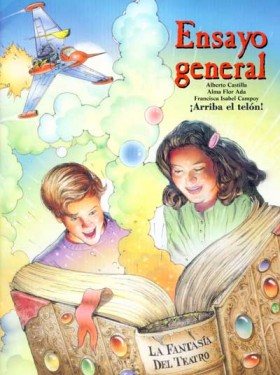
Book Description
This theatre anthology includes four plays: Historia de una muñeca abandonada by renowned Spanish playright Alfonso Sastre, Fábula del buen hombre y su hijo, by Mireya Cueto, La Cenicienta: versión desempolvada, by Isabel Campoy and La calle de los fantasmas by Javier Villafañe.
Historia de una muñeca abandonada is one of the best plays ever written in Spanish for children. This drama, in verse form, inspired in King Salomon’s judgement, brings to question who is the true owner of a doll, the girl who received it as a gift, mistreated and abandoned it, or the girl who found it and tended for it carefully.
Besides having a profound content, the play is a model of good theatre following the best traditions of theatre in the Spanish language, including changing the metric to adjust to the particular emotions and feelings of each act.
La Cenicienta: version desempolvada by Isabel Campoy is a witty version of the old Cinderella tale now brought to modern times.
La fábula del buen hombre y su hijo is a dramatization of the popular fable in an excellent dramatization by Mireya Cueto.
La calle de los fantasmas is an original play by one of the best authors of children’s theatre in the Spanish language, Javier Villafañe.
The book also includes five sections that will inform children on various aspects of the theatre and will facilitate their getting involved with different forms of staging a play: Sonido y utilería. Los títeres. Las máscaras. Teatro de sombras. Glosario de teatro.
Using this book
The values of the use of involving children with theatre are multiple. Plays can be an excellent tool for promoting the ability to speak in front of a group, which is a leadership skill. Since they offer children the opportunity to utilize words and language registries they may not have other opportunity to use, plays can be strong vehicle for vocabulary and language development.
When used for choral reading plays can strengthen reading skills. In addition, acting on a play enhance children’s self-confidence and self-esteem while providing opportunities to learn about one’s self and others. Most importantly, putting out a play, no matter how simply, promotes the values of collaboration and solidarity.
To read more on the significance of theatre click here: Let’s Raise the Curtain! The Benefit of Theatre in the School and for suggestions on its use in the classroom read the section “Plays and Dramatic Games” in Chapter 3 of The Magical Encounter: Latino Children’s Literature in the Classroom and for dramatic responses to books, the section “Promoting Dramatic Expression” in Chapter 4 of that same book.
Author’s Note
Theatre has been a passion in my life. I was part of every play during my school years and later in High School I also begun writing. One of my plays “The Museum” was chosen to be performed as the theatrical event of our class graduation. Theatre was a way of life for me during those early years.
Because of my experience with theatre, and how important it was in giving me a voice, breaking the barriers of shyness, and encouraging me to speak in public; ensuring that children have access to read and act in plays has always been one of my basic goals. Even if it is done with great simplicity, acting in a play can have very positive results.
I am convinced that one is better able to teach something one has enjoyed doing. And just as Alma Flor Ada and I emphasize, in our courses in Authors in the Classroom, that teachers who create their own books will be better able to get their students to become authors, I believe that encouraging teachers to do theatre and experiencing the richness of the process would better allow them to incorporate plays in their regular teaching.
ABOUT ¡CURTAINS UP! THE CIELO ABIERTO THEATRE COLLECTION
Each of the seven anthologies in this series offers a variety of plays well-suited for either reading aloud or for full-scale performance. For the early grades, Alma Flor Ada and F. Isabel Campoy have created original adaptations of traditional children’s stories. Familiar tales are retold in the form of plays, choral poems, and theatre games, inviting children to explore movement, characterization, and imaginative play. The use of traditional Hispanic folklore, woven into the dialogue, enhances the cultural setting in which the stories have been recast. For the older grades, a selection of the best plays written for children throughout the Spanish-speaking world has been carefully assembled.
The anthologies are:
- Primer acto [PreK-2] 48 pages
- Risas y aplausos [K-3] 48 pages
- Escenas y alegrías [1–4] 48 pages
- Actores y flores [3–6] 64 pages
- Ensayo general [4–7] 80 pages
- Saludos al público [5–8] 96 pages
- Acto final [5–8] 96 pages